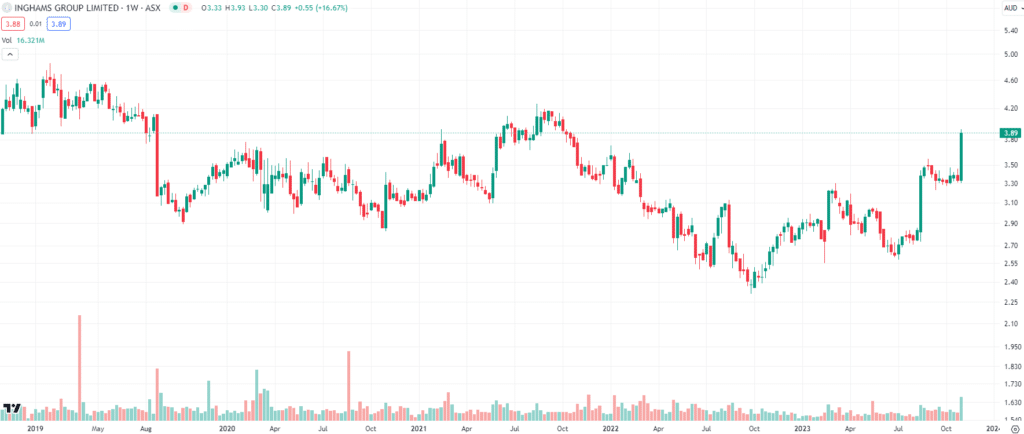Inghams (ASX:ING): Why the sudden surge in the last 3 months?
![]() Nick Sundich, November 6, 2023
Nick Sundich, November 6, 2023
It has been a tough year on the ASX but not for poultry company Inghams (ASX:ING). Its shares are up 46% in 2023. Has it just been lucky, or has the company been doing something right to merit its performance?
It is the latter. And there is a lot to like about this company. It possesses many positive traits including a market-leading position, a long history and being in a recession-proof industry – although this has not always helped it.
Introduction to Inghams (ASX:ING)
Inghams traces its origins back to 1918 and was a family-owned poultry business for several decades. Over time, it expanded into turkey and stockfeed and became a supplier towards major retail and quick service restaurants. Chicken is a popular food option because it is cheaper and healthier than red-meat. 70% of Australian families have it at least 3 times a week.
The company was sold to private equity giant TPS in 2013 and went public in 2016. TPS sold roughly half its stake at listing and gradually sold it down once the escrow period expired, exiting for good in 2020.
Inghams has not had the easiest life as a listed company even though its results have been far from terrible. However, it seems a major corner has been turned in 2023.

Inghams (ASX:ING) share price chart, log scale (Source: TradingView)
An ‘eggcelent’ 2023?
Actually, it has only been recent weeks when Inghams shares have performed well. For much of the pandemic and its aftermath, it has battled higher input costs, including feed, packaging and freight, as well as supply chain challenges. And even though Inghams is the largest poultry company, its customers did have alternatives and its competitors had their own supply.
But now, those difficult times are over. In August 2023, the company released its FY23 results and it reported a $60.4m profit, up 72% in 12 months. This was in spite of Poultry Volumes going 0.4% backwards, because the company was able to pass on cost increases to its customers. It delivered a ROIC of 19%, up from 13.7% the year before.
Upgraded guidance for 2024
Fast forward 10 weeks or so, and the company gave a trading update for the first few months of the year that led it to upgrade its 1HY24 guidance. It is expecting a $65m statutory profit, a figure that would be up 7% from the year before. Of course, this is contingent on current trading levels being maintained. And the company expects results from the second half to be lower than the first half due to normal seasonality.
Consensus estimates call for $3.3bn in revenue and a $111.5m profit for the full FY24, figures which represent growth of 10% and 87% respectively. The company’s current share price places it at 12.3c P/E and less than 0.5x PEG. The latter is a key teller that the company could be undervalued, relative to its growth.
What we think Inghams is worth
Despite the optimism analysts have in Inghams – all 11 of them – the mean share price is $4.02, barely 4% above the current share price. Granted, there is a significant divergence of opinion with the lowest being $3.05 and the highest being $5.30.
We think the company is $5.73 per share on a DCF basis, using consensus estimates and a 9.1% WACC. This is a 50% premium to the current share price. On a Relative value basis, it could be worth $6.47 – a 70% premium. This is using a 23.3x P/E from its peers (including Bega and Costa in Australia, as well as Pilgrims Corp, Tysons Foods and Hormel Foods).
Obviously, the risks with this one as the impediments the company has faced returning with a vengeance. Namely, supply chain issues, competition and potentially macroeconomic softness. Investors appear to think the worst is behind the company, and they could be wrong. But if they are not, Inghams is set for a much better next 7 years listed than its first 7.
What are the Best ASX Stocks to invest in right now?
Check our ASX stock buy/sell tips
Blog Categories
Get Our Top 5 ASX Stocks for FY25
Recent Posts
Your invitation to the Freelancer Investor Day
Your invitation to the Freelancer Investor Day Freelancer (ASX: FLN) is a Sydney-based company that has been the subject of…
Kamala Harris stocks: If Joe Biden’s VP wins the White House in 2024, which stocks will win?
With the US Presidential election now certain to be a Kamala Harris v Donald Trump showdown, we’ve looked at so-called…
South32 (ASX:S32): Is it the dark horse amongst ASX 200 miners or have cyclones and commodity prices hit it too hard?
South32 (ASX:S32) began life as a spinoff from BHP back in 2015, capitalised at $9bn. In mid-2024, it is capped…



